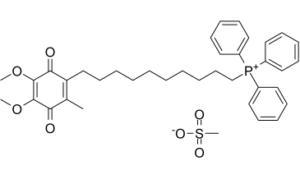This product is for research use only, not for human use. We do not sell to patients.

| Size | Price | Stock |
|---|---|---|
| 250mg | $1020 | To Be Confirmed |
| 500mg | $1480 | To Be Confirmed |
| 1g | $2220 | To Be Confirmed |
Cat #: V4979 CAS #: 845959-50-4 Purity ≥ 98%
Description: Mitoquinone mesylate (also known as MITOQ; MitoQ or MitoQ10), the mesylate salt of Mitoquinone, is a novel and potent TPP-based, mitochondrially targeted antioxidant designed to accumulate within mitochondria in vivo in order to protect against oxidative damage.
Publications Citing InvivoChem Products
Product Promise

- Physicochemical and Storage Information
- Protocol
- Related Biological Data
- Stock Solution Preparation
- Quality Control Documentation
| Molecular Weight (MW) | 678.81 |
|---|---|
| Molecular Formula | C38H47O7PS |
| CAS No. | 845959-50-4 |
| Storage | -20℃ for 3 years in powder formr |
| -80℃ for 2 years in solvent | |
| Synonyms | Mitoquinone mesylat; MitoQ mesylate; MitoQ10 mesylate |
| Protocol | In Vitro | Mitoquinone (MitoQ) is a mitochondria-targeted antioxidant.The optimal doses for Mitoquinone (MitoQ) and DecylTPP treatment are selected from dose-response experiments during 4-h cold storage (CS). The potential protective benefits of Mitoquinone treatment against CS injury are tested initially using MitoSOX Red, a mitochondrial-targeted fluorescent dye that measures mitochondrial superoxide generation. Normal rat kidney (NRK) cells exposed to CS result in a ~2-fold increase in fluorescence due to mitochondrial superoxide compared with untreated cells. Mitoquinone offers significant protection against CS-induced mitochondrial superoxide generation; whereas the control compound DecylTPP does not offer any protection. Mitoquinone treatment markedly decreases mitochondrial superoxide generation, whereas kidneys treated with DecylTPP have comparable levels of mitochondrial superoxide to kidneys exposed to CS alone. |
|---|---|---|
| In Vivo | Mitoquinone (MitoQ) treatment significantly reduces pancreatic oedema and neutrophil infiltration. MitoQ dose-dependently increases serum amylase with an approximate doubling at the higher dose. MitoQ treatment nearly doubles lung MPO activity induced by Caerulein with a significant increase of serum IL-6 levels also evident at 10 mg/kg (dose 1). |
| Solvent volume to be added | Mass (the weight of a compound) | |||
|---|---|---|---|---|
| Mother liquor concentration | 1mg | 5mg | 10mg | 20mg |
| 1mM | 1.4732 mL | 7.3658 mL | 14.7317 mL | 29.4633 mL |
| 5mM | 0.2946 mL | 1.4732 mL | 2.9463 mL | 5.8927 mL |
| 10mM | 0.1473 mL | 0.7366 mL | 1.4732 mL | 2.9463 mL |
| 20mM | 0.0737 mL | 0.3683 mL | 0.7366 mL | 1.4732 mL |
This equation is commonly abbreviated as: C1 V1 = C2 V2
- (1) Please be sure that the solution is clear before the addition of next solvent. Dissolution methods like vortex, ultrasound or warming and heat may be used to aid dissolving.
- (2) Be sure to add the solvent(s) in order.




































